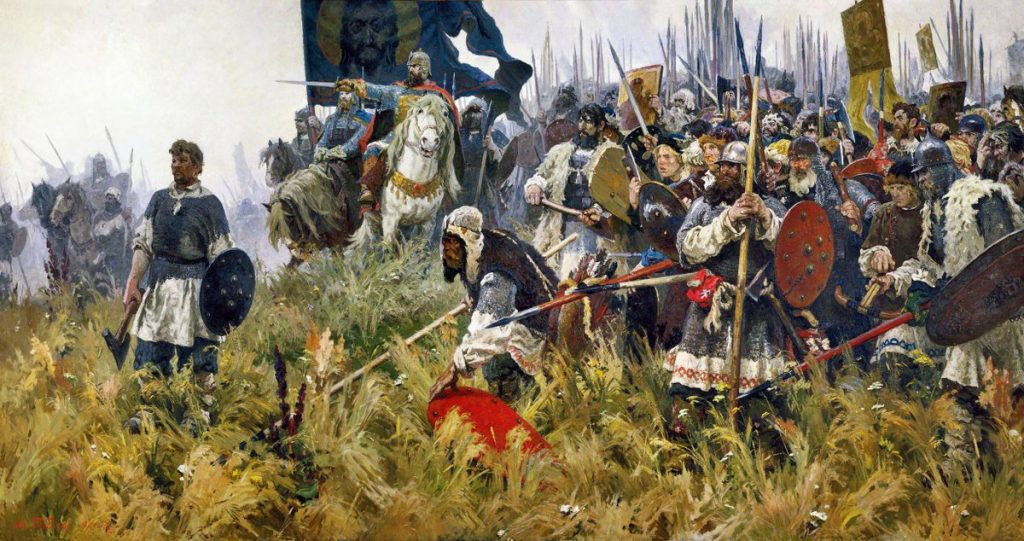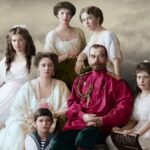Blog Post
In Russia: From the Mongol yoke to the Bolshevik barbarians
By Jonathon Van Maren
Author’s Note: My first essay in this series on Russian Orthodoxy, covering the legendary arrival of the Apostle Andrew in Kiev to the Mongol invasion, was published last week. You can read The Bloody Baptism of Russia here.
We arrived in Sergiyev Posad by train from Moscow, and snow was falling lightly as we exited the station. Our destination was the Trinity Lavra, a cluster of cathedrals and a monastery that were begun in the 15th century by Sergius of Radonezh–now considered to be one of the holiest sites in Russian Orthodoxy. The remains of Sergius, who is perhaps the most famous monk-saint in Russian Orthodox history, lies in an ornate glass-topped gold coffin presided over a priest who conducts a near-perpetual funeral service, humbly attended by crowds of pilgrims who come to pay their respects. We weren’t sure what we would find in Sergiyev Posad, but discovering that a funeral was underway for a man who died in 1392 was definitely not on the list.
Historians aren’t sure of Sergius’ precise birthdate—it could be 1314, 1319, or 1322. What they do know is that he was ordained to the priesthood and became a monk in 1337 along with his widowed older brother Stephen. The brothers then set off deep into the forests to build a small chapel and single-cell monastery—Stephen left after only a few years when the seclusion proved too much for him. For years, Sergius lived alone in the forest among the animals—packs of wolves came right up to his hut, but would depart without harming him. Legend has it that a bear came to share Sergius’ bread with him—one historian we spoke with referred to him as “the Bear Saint.” The Catholic Francis of Assisi had birds, and the Orthodox Sergius of Radonezh had a bear. How very Russian, we thought.
When people began to hear of Sergius, they traveled deep into the forest to seek spiritual guidance—and some began to stay. His single cell grew into a hermitage with first twelve monks, and then more. This was the beginning of Trinity Lavra. People still flock here to view the remains of Sergius, which rest beneath a brown cloth, and to view the gorgeous churches and ornate icons. My friend and I realized very quickly as we explored that we were virtually the only tourists—nearly everyone else was there as pilgrims. Even Sergius’ corpse is surrounded by legend: When the Bolsheviks attempted to expose his body to a crowd to prove that it was nothing more than rotten bones and that nothing would happen to the grave-robbers if they desecrated the remains, they were proven wrong. Something did happen—specifically, the Bolshevik commander in charge of the operation was jerked off his horse and beaten badly by a crowd of incensed believers.
It was in 1380 that the religious life of Sergius of Radonezh merged with the bloody national history of Russia. When we left off in our story, the Mongols had overrun Rus and laid waste to the people and the land, subjugating them under the iron yoke of the Golden Horde. Prince Dmitri Donskoy arrived at Trinity Lavra to visit Sergius before meeting the Tatars in battle, and received what he had come for: A blessing. “Go forth, my lord fearlessly!” Sergius told him. “The Lord will help you against the godless enemy.” To aid him on his way, Sergius sent two warrior-monks with Dmitri—one was Alexander Peresvet, the legendary horseman who killed his champion Tatar opponent and smashed him from his saddle in single combat at the opening of the Battle of Kulikovo before dying astride his steed.
As the Russian forces crashed into the Tatar warriors, Sergius and his monks gathered in the church to pray for victory. Victory was granted–the first step in the liberation of Rus from the Tatar occupation. What most historians consider to be the final liberation would occur almost exactly a century later in 1430 at the Great Stand on the Ugra River, where the Grand Prince Ivan III of Muscovy faced off with Akhmat, the khan of what was by then simply called the Great Horde. Grand Prince Ivan, like Prince Dmitri before him, also sought a blessing from the Orthodox Church before meeting the Mongols, and it was given—church leaders begged him to protect the Church from the infidels. (Ironically, the Mongol infidels had enormously strengthened the Orthodox Church by refusing to tax it, seeing it as a way of preventing infighting among Rus princes.) To everyone’s utter astonishment, the standoff at the Urgra River resulted in the Tatars deciding to turn heel and leave. Prince Ivan headed to church to thank God for his tremendous and nearly bloodless victory.
As is so often the case, the brutal Tatar occupation only increased the centrality and prominence of the churches. These ancient churches are everywhere in Russia, despite the fact that many of them are now in ruins after the rage-fuelled iconoclasm of the Bolshevik barbarians laid waste to people and buildings for death-filled decades. To walk in these churches is to breath in history that hangs in the air like the misty layers of incense—they are old, and have played host to Russia’s past. Exploring the cathedrals of the Kremlin’s Red Square alone gave us a taste of this history: The Dormition Cathedral with its glowing golden dome was consecrated in 1479, and replaced a wooden church that was purportedly erected there in the 1100s. It hosted the coronations of the Tsars from 1547 to 1896, and most of the Moscow Metropolitans were buried there—it is, after all, only separated from the Patriarch’s palace by a narrow alley. Ivan the Terrible himself was the first to be crowned here.
Nearby is the Annunciation Cathedral, consecrated in 1489 and once serving as a chapel for the Tsars. The Cathedral of the Archangel was built on the site of an earlier church from 1250, and the Tsars and Grand Princes were buried here until the reign of Peter the Great. The Ivan the Great Bell Tower was once part of the original Church of the Resurrection, which was blown up by Napoleon during his invasion of Moscow. To walk into these old churches is to enter the presence of a multitude of dead men, some of them monks, some of them murderers. The air feels heavy in these cavernous and candle-filled places, filled with murmuring, head-bobbing worshippers and their respectful spectators. In St. Basil’s Cathedral, the iconic cathedral shaped as the flame of a bonfire rising skyward, we heard the deep, rumbling voices of singers echoing their centuries of predecessors rising towards the steeple as women in colorful shawls and men with hats in their hands stopped respectfully to listen. St. Basil’s, which has served as the backdrop to nearly every Western media story on Russia for decades, was built in 1551-61 on the orders of Ivan the Terrible to thank God for his victory over Kazan and Askrakhan.
Just as the Catholic Church would become central to the Polish struggle to preserve their culture and their nation in the face of Soviet Oppression in the 20th century, the Russian Orthodox Church was pivotal to the survival of the Russian peoples during the years where they groaned under the Mongol yoke. In the following centuries—despite sometimes brutal infighting over various heresies—Orthodox churches grew in both size and influence, rebuffing multiple attempts by Catholic ambassadors to woo the Russians into placing themselves under the authority of the pope. In the 1540s, while Western Europe descended into the maw of the religious wars, the Russian Orthodox convened synods that codified their hagiography and their ceremonies, consolidating their traditions and expanding their power. They used this power to remove themselves from government jurisdiction, and even to challenge the policies of the Tsar when the Orthodox hierarchy saw fit. This didn’t always go well—when Metropolitan Phillip refused to grant Ivan the Terrible communion and condemned his various massacres, Ivan had him arrested, deposed, and then strangled to death in 1569 two days before Christmas.
No monarch or government, of course, likes to be rebuked by men of the church—especially not when their bloody ways ensure that such denunciations are necessary. And so when Peter the Great (1682-1724) embarked on his quest to implement reforms across Russia, modernize the nation, and transform the Russian Empire into a spectacularly powerful political and military force, he decided to also bring the Orthodox Church back under state control. Cleverly, he replaced the Patriarch with a Holy Synod, and then seized the right to appoint all of the bishops—sycophants dependent on him for their prestigious positions were far preferable to prophets prone to condemn wickedness they saw in their Tsar. Peter himself had little use for the Church or Christianity, and so the religious orders suffered not only because the Tsar himself oversaw church affairs that had once been left to the clergy, but also because many men rejected religious vocations as one that would be accompanied by too much scorn and loss of prestige. As such, the clergy became increasingly poor and uneducated—a situation exacerbated later by Catherine the Great, who seized nearly all church lands and reduced the salary of priests even further.
Despite these setbacks—the Russian Orthodox Church and the Russian state have been alternatively intertwined or struggling for predominance for centuries, and that dance continues still—Russian Orthodoxy still continued to spread exponentially as missionary efforts as far away as Siberia and Alaska brought new converts into the fold. As the clock ticked towards the Bolshevik Revolution and the sand ran out of the Imperial hourglass, many of the Russian elites began to return to Orthodoxy or other forms of Christianity—Tolstoy writes eloquently in his final novel Resurrection of elite gatherings in assorted palaces where nobility gathered to hear preachers speak of the renewal of the soul. As rumblings of revolution lurked on the edges of Russian consciousness—Tsar Alexander II had been assassinated by a bomb-wielding terrorist revolutionary in March of 1881—there was a growing realization that answers to the existential questions filtering through Russian society were desperately needed.
In 1909, a group of liberal intellectuals including Sergei Bulgakov, an Orthodox theologian, philosopher, and economist, Peter Struve, a philosopher and editor, and a number of other prominent scholars (five of whom were former Marxists), attempted to address some of these fundamental questions in a volume of seven essays called Vekhi (Landmarks). Nikolai Berdyayev, an Orthodox philosopher, condemned the utilitarianism of the elites and explained that materialism had eliminated any interest in actually seeking truth. Bulgakov warned that the fight for socialism could not lose sight of individual rights. The essays in Vekhi also emphasized that the Marxist obsession with creating a utopia on earth was extraordinarily dangerous—especially because Marxists labeled those who disagreed with them as enemies, and he additionally noted the moral bankruptcy of atheism. One author even accused Russian students of a growing moral relativism. The book caused a sensation—the most controversial sentence being penned by the essayist Mikhail Gershenzon, who wrote that the dangers of Marxism were repellant to him and that “far from dreaming of union with the people we ought to fear the people and bless this government which, with its prisons and bayonets, still protects us from the people’s fury.”
History is littered with tragically ignored prophets who were forced to see the evils they warned of come to pass, but the valiant attempt by the authors of Vekhi to urge the Russian intelligentsia to alter course is particularly poignant considering the events that were to come less than a decade later. Men like Vladimir Lenin–whose bloodlust was driven by the execution of his older brother, a terrorist who attempted to assassinate Tsar Alexander III on the anniversary of the murder of Alexander II—led a Revolution that would unleash a deluge of blood unparalleled in Russia’s long, violent history. The clergy and faithful of the Russian Orthodox Church would be among the very first victims—they were flung from cliffs, crucified, and butchered in their churches. Most of the Vekhi authors were forced to flee the carnage they had tried to warn of, with Bulgakov and Struve dying in Paris, Berdyayev dying in Clarmart, and only Gershenzon dying in Moscow.
For centuries, the Russian state and the Russian Orthodox Church had struggled for the souls and the loyalties of the Russian people. With the Tsar and his wife and children shot to death and then burned in a remote Siberian town on the edge of the Empire, the Bolsheviks turned to their primary rival for the affections of the people—and unleashed a persecution on a scale that has never been seen before or since. The Russian Orthodox Church had faced challenges before, but the systematic brutality of the godless Communists would make the murderous spasms of the demented Ivan the Terrible seem almost restrained in comparison.
Author’s Note: Part III of my Russia series, on the great Soviet persecutions, will appear next week.
__________________________________________________
For anyone interested, my books: The Culture War, Seeing is Believing: Why Our Culture Must Face the Victims of Abortion, and How To Discuss Assisted Suicide, are available for sale here.








